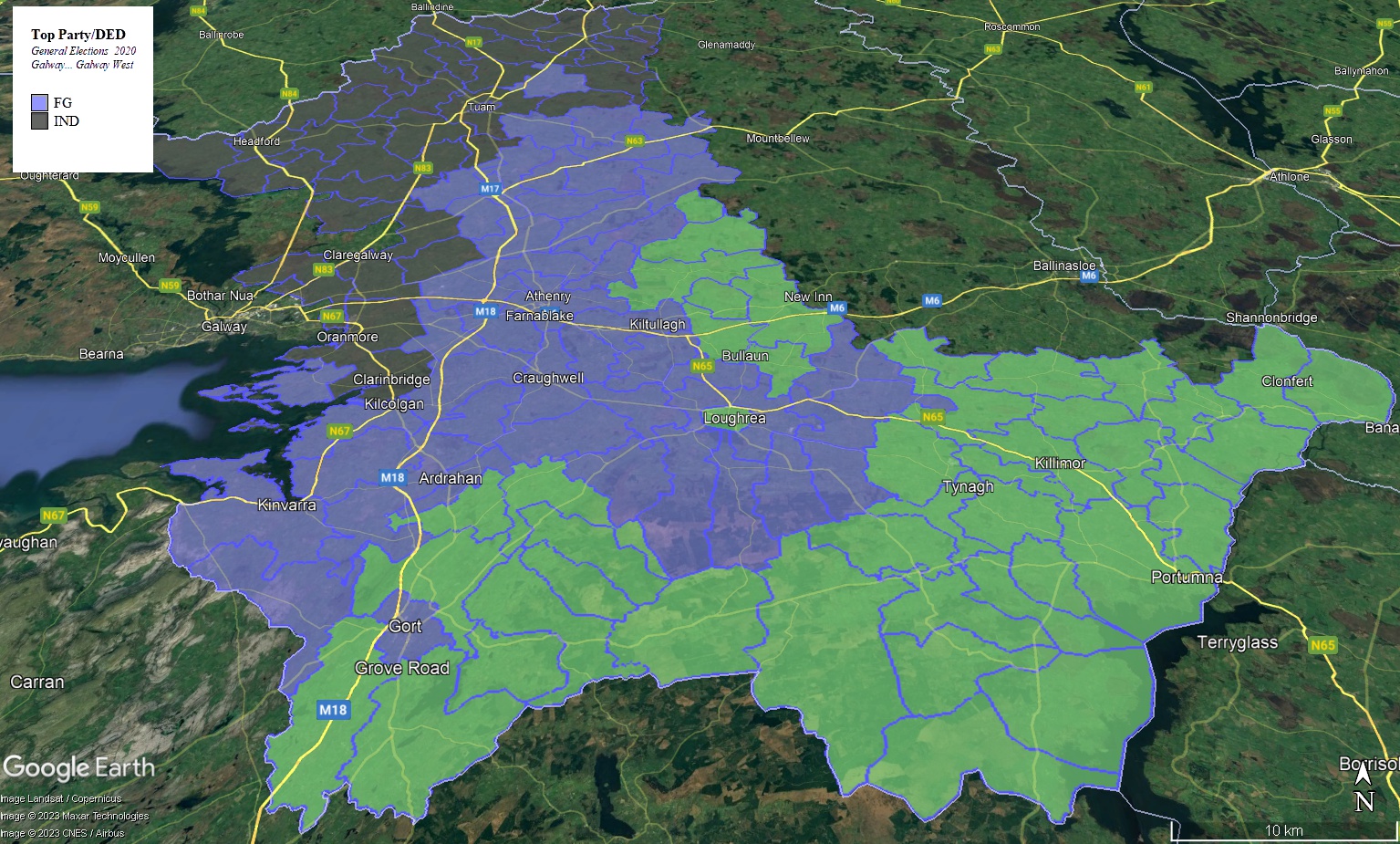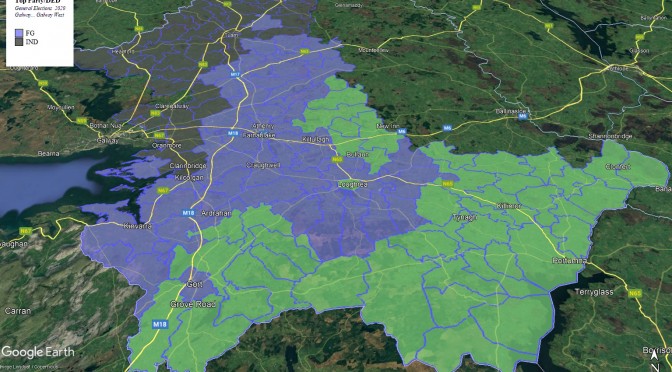In this post, I will be gradually working through the possible permutations of constituencies that the recently formed Electoral Commission might consider.
Unfortunately I’m slightly shooting blind, as the Terms of Reference merely state that “the total number of members of the Dáil, subject to Article 16.2.2° of the Constitution, shall be not less than 171 and not more than 181”. Apparently, the precise number of members the Dáil will not be set until after the Central Statistics Office releases the final population figures (sometime in the summer months) and will not be revealed until the Constituency Review report is released probably in the Autumn.
However, there seems to be a general concensus amongst people wiser than myself that the final number is likely to be somewhere between 176 and 181 in order to “future-proof” whatever scheme of constituencies is arrived at.
Accordingly, I have decided to ensure that my constituency examples below (examples – not proposals) would be within the permitted 5% variation from the National average of Population per TD for both 178 and 180 seat models.
Just to reiterate that these are examples of what the Electoral Commission MIGHT do, rather than what they WILL do – or indeed, what I think they SHOULD do.
VARIANCE
The below table shows the population limits (positive or negative) that for constituencies to be valid. Each constituency has to have a Population per TD ratio within 5% of the National Average.
TABLE 1 – PERMITTED VARIATIONS IN POPULATION FOR CONSTITUENCIES
| MAGNITUDE | 178 | 180 | ||
| Minimum | Maximum | Minimum | Maximum | |
| 3 seats | 82,034 | 90,669 | 81,123 | 89,662 |
| 4 seats | 109,379 | 120,892 | 108,164 | 119,549 |
| 5 seats | 136,724 | 151,116 | 135,204 | 149,436 |
TERMS OF REFERENCE
The Terms of Reference for the Electoral Commission are as follows.
- the total number of members of the Dáil, subject to Article 16.2.2° of the Constitution, shall be not less than 171 and not more than 181*;
- each constituency shall return 3, 4 or 5 members;
- the breaching of county boundaries shall be avoided as far as practicable.
- the reference to county boundaries shall be deemed not to include a reference to the boundary of a city or any boundary between any 2 of the counties of Dún Laoghaire-Rathdown, Fingal and South Dublin.
- each constituency shall be composed of contiguous areas;
- there shall be regard to geographic considerations including significant physical features and the extent of and the density of population in each constituency; and
- subject to the above matters, the Commission shall endeavour to maintain continuity in relation to the arrangement of constituencies.
The two important terms for me are Numbers 3 and 7, as logically interpreted it means that the integrity of county boundaries is prioritised over the continuity of current Constituency boundaries – including presumably those where county boundaries are breached.
As regards Number 2, I think it’s regrettable that larger constituencies are not permitted – besides allowing for a better share of representation, there is a reasonable case for their use in larger counties (ie Galway) or indeed in large cities (ie Dublin and Cork)
CONNAUGHT AND ULSTER
I’m going to examine the Connaught and Ulster constituencies in three distinct groups :
- South Connaught (Galway, Mayo and Roscommon)
- North Connaught and Ulster (Donegal, Sligo and Leitrim)
- North Leinster (Cavan-Monaghan and others)
Cavan-Monaghan is included in North Leinster as seven DEDs in Meath are currently part of the Cavan-Monaghan constituency
SOUTH CONNAUGHT
Firstly, the reasoning behind choosing to group these three counties.
The constituencies of Galway East, Galway West, Galway-Roscommon and Mayo together account for 16.5 seats worth of population – a rather awkward number halfway between 16 and 17. However, the constituencies of Donegal and Sligo-Leitrim to the north jointly have 9.72 swp, bringing the sum total to 26.22 swp.
Putting 16 seats in Galway, Mayo and Roscommon means that the average variation will be 3% above the average, and obviously can’t go above 5%.
Below are the statistics for counties in South Connaught
TABLE 2 – POPULATION BY COUNTY/CITY
| CONSTITUENCY | POPULATION | 178 SEATS | 180 SEATS |
| Galway City | 83,456 | 2.90 | 2.96 |
| Galway County | 192,995 | 6.70 | 6,78 |
| Mayo | 137,231 | 4.77 | 4.82 |
| Roscommon | 69,995 | 2.43 | 2.46 |
Mayo has just about enough population for 5 seats by itself; however each constituency in this area would need to have a ratio of population per TD above the national average.
Interestingly Galway City has enough population to be a stand-alone three-seater – I might have a look at such an option shortly.
Roscommon is stuck somewhere between 2 and 3 seats in terms of seats worth of population. Accordingly I probably won’t interfere with the portion of North Roscommon currently within the Sligo-Leitrim constituency.
TABLE 3 – POPULATION BY CONSTITUENCY
| CONSTITUENCY | POPULATION | 178 SEATS | 180 SEATS |
| Galway East | 97,016 | 3.37 | 3.41 |
| Galway West | 154,596 | 5.37 | 5.43 |
| Mayo | 131,353 | 4.56 | 4.61 |
| Roscommon-Galway | 92,128 | 3.20 | 3.24 |
Galway-Roscommon needs to lose a small bit of population (about three thousand) to be within the permitted bounds of variation of Population per TD.
GALWAY EAST (4 seats)
The constituency of Galway East would include the current constituency plus DEDs in Tuam LEA from Galway-Roscommon (which would bring all of the DEDs in Tuam into Galway East) and the DEDs of An Carn Mhor, Baile na Teampall, Ballynacourty, Ceathru an Bhrunaigh, Clarinbridge, Leacach Beg, Liscananaun, Lisheenavalla, Oranmore in Athenry-Oranmore from Galway East.
TABLE 3 -GALWAY EAST CONSTITUENCY DEDS
| Constituency | DISTRICT ELECTORAL DIVISIONS | POPULATION |
| Galway East | ALL DEDs | 97,013 |
| Galway West | The DEDs of An Carn Mhor, Baile na Teampall, Ballynacourty, Ceathru an Bhrunaigh, Clarinbridge, Leacach Beg, Liscananaun, Lisheenavalla, Oranmore in ATHENRY-ORANMORE | 19,758 |
| Galway-Roscommon | The DEDs of Clonbern, Carrownagur, Dunmore North, Dunmore South and Toberadosh in TUAM | 3,272 |
First established in 1937 as a four-seater, Galway East was effectively a three-seater for its first four elections as Frank Fahy (Fianna Fáil) was Ceann Comhairle.
Fianna Fáil held two of the three elected seats in each of those four elections taking over 60% of the vote in both 1938 and 1944 suggesting they would have won three out of four in an open election in those years – they also probably would likely have taken three in 1937 as well.
1943 saw Michael Donnellan take a seat for Clann Na Talmhan, a seat which he held until his death in Croke Park in 1964 when he collapsed with a heart attack after Galway won the All-Ireland; his sons John and Pat were on the Galway team that day. Legend has it that a Fianna Fáil was sent to the Donnellan homestead to enquire if John would be interested in running for Fianna Fáil in the bye-election; he arrived to find a Fine Gael car already parked there. John would hold a seat for Fine Gael for 25 years.
1943 also saw Robert Burke of Labour get 14% of the vote, their best performance until 2011. In 1944 the election was a straight contest between Fianna Fáil and Clann na Talmhan – Fine Gael did not contest.
Between 1948 and 1961 the constituency was split into two three-seaters Galway North and Galway South.
Fianna Fáil pulled off a remarkable win in 1948 – otherwise a bad year for them – by taking all three seats in Galway South. Ceann Comhairle Frank Fahy accounted for one seat. In the contest for the remaining two seats, Fianna Fáil took 64% of the vote compared to 19% for Clann Na Poblachta (split between two candidates) and 17% for Fine Gael – Patrick Beegan of Fianna Fáil took nearly half the vote. On the third count Patrick Cawley of Fine Gael was 77 votes ahead of Vincent Shields of Clann na Poblachta and 2,245 votes behind Robert Lahiffe of Fianna Fáil with 4,266 votes to be distributed. Fine Gael beat Fianna Fáil over 5 to 1 in transferable votes (40% to 7%), but crucially 53% were non-transferable meaning Lahiffe won the last seat by 724 votes. Fianna Fáil took over 55% in every contested election here, and in 1957 took 64% again.
Fianna Fáil were weaker in Galway North, and didn’t take over 50% of the vote here between 1948 and 1961; James Hession of Fine Gael was elected alongside Michael Donnellan in 1951 and 1954, being brought over the line by Clann Na Poblachta and Clann na Talmhan transfers.
Galway East was reunited as a five seater in 1961 and 1965, with Fianna Fáil taking three of the five seats on both occasions. Even having All-Ireland winner John Donnellan on the Fine Gael ticket in 1965 couldn’t shift party loyalties much.
For 1969 and 1973 Galway East was again split into two constituencies, Clare-South Galway and Galway North-East. Fianna Fáil took two out of three seats in both areas in both elections.
In 1977, Galway East reappeared as a 4-seater and Fianna Fáil took three of the four seats with 59% of the vote; they also took three out of four in Galway West. From 1981 until 1992 the constituency was a three-seater returning two Fianna Fáil and one Fine Gael TD. In 1997 it became a four seater which it remained until 2011.
MAP 1 – PROPOSED GALWAY EAST CONSTITUENCY

The constituency would actually be split into three domination sections – Fianna Fáil throughout much of the South, Fine Gael in the centre and Independents in the North-West.
The latter is actually made from the poll-topping performances of three Independent TDs in three different constituencies – Michael FitzMaurice in Roscommon-Galway in the far north, Sean Canney in the Tuam area of Galway East, and Noel Grealish in Galway West.
The acquisition of the areas to the east of the city (Clarinbridge, Oranmore etc.) actually give it a much more natural shape.
TABLE 4 – PARTY SUPPORT BY LEA
| SF | FG | FF | GP | SD | OTH | IND | % | |
| Tuam (pt.) | 12% | 26% | 20% | 3% | 1% | 3% | 35% | 25% |
| Loughrea | 19% | 25% | 35% | 4% | 1% | 3% | 13% | 21% |
| Athenry-Oranmore (GW) | 11% | 18% | 15% | 5% | 5% | 5% | 42% | 18% |
| Gort-Kinvara (pt.) | 18% | 32% | 25% | 7% | 5% | 6% | 8% | 16% |
| Athenry-Oranmore (pt.) | 19% | 36% | 23% | 5% | 2% | 3% | 13% | 14% |
| Tuam (Ros.-Gal.) | 13% | 11% | 10% | 2% | 0% | 2% | 64% | 3% |
| Ballinasloe (pt.) | 12% | 30% | 29% | 4% | 1% | 4% | 10% | 2% |
| TOTAL | 15% | 26% | 23% | 4% | 2% | 3% | 24% |
The Fianna Fáil vote was best in its traditional heartland of south Galway, while Independents were dominant in the North.
GALWAY WEST
Coming soon….
ROSCOMMON GALWAY
Coming soon….
MAYO
Coming soon….
